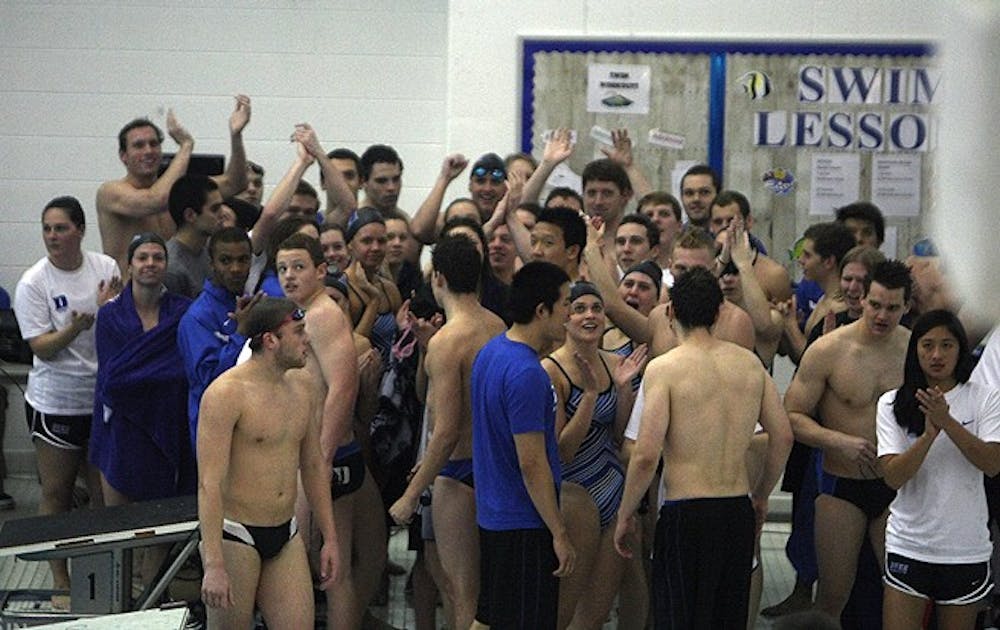Even though the Duke men and women broke 17 school records at the ACC Championships last week, the teams’ seventh-place finishes could have been affected by scholarship funding disparities.
According to the NCAA Division I manual, a swimming and diving team can have a maximum of 14 women’s and 9.9 men’s scholarship or grant equivalencies. Duke currently provides .35 scholarship equivalencies on the men’s side and 2.54 on the women’s, Deputy Director of Athletics Chris Kennedy wrote in an email Tuesday.
Virginia is one of the fully funded teams in the ACC. The Cavaliers have won six consecutive ACC men’s championships and also won the women’s title this year.
“[Duke is] spectacular for being a program that is not fully funded—maybe the best in the country,” Virginia head coach Mark Bernardino said.
As a partially-funded team, Duke head coach David Colella noted that the discrepancies in funding sometimes translate to a difference in performance in the pool. Bernardino echoed the same observation.
“Teams that are funded with athletic grant-made money will almost always perform at a higher level than those without grant-made money,” Bernardino said. “They’re able to attract people to their university that they might not otherwise be able to attract without scholarship money.”
Funding may also affect how individuals perform on a regular basis, Bernardino added.
“I would hope that any athlete would perform to the very best of his or her abilities at all times. However, it may be that if [athletes] are not funded at any level, physiologically [they] may not put in as much effort as they might otherwise should they be funded,” Bernardino said. “It may in fact be true, but I guess it would depend on each individual and their commitment to the sport.”
Although Duke only has a few scholarships now, Colella noted that it is still a positive change from when he began his tenure at the University.
“When I first got hired we were actually a non-funded program, meaning no scholarships,” he said. “The athletic department supports us in all other realms, and they have actually, over the course of my tenure here, added scholarships to the program.”
In contrast, Virginia’s swimming and diving program has been fully funded since the 2000s, Bernardino said. He added that because there are always more athletes than scholarships on any swimming and diving team, dividing scholarship money between multiple athletes is more common than awarding fewer full scholarships.
Although Duke is not fully funded, Colella said Duke’s reputation for strong academics helps in recruiting.
“Swimming and diving is a sport where professionalism [is not the norm]. Michael Phelps is one in a trillion, so there’s not a lot of opportunities to make money,” Colella said. “For us, the fact that Duke is such an incredible academic institution is attracting a lot of quality swimmers and divers because they want to get a great education because they’re looking beyond their sport.”
The difference between a public and a private institution also plays a role in funding and recruiting. Private schools are more able to fund a student-athlete’s education if he or she demonstrates financial need. On the other hand, public universities attract a higher volume of students and have a larger pool of alumni to reach out to for fundraising.
Even though Virginia offers the full allotment of scholarships allowed by the NCAA, Bernardino said swimming and diving programs are underfunded relative to other NCAA sports. The Duke athletic department declined to comment on the scholarship allotments for other Duke non-revenue sports.
“From my perspective I would like to see more funding in our sport rather than less or [the] status quo—9.9 scholarships for men’s swimming is a low number for the size of teams that we field and for the number of events that we compete in,” Bernardino said. “Likewise, I think that 14.0 for women is a fair number for the number of athletes that we need to field a team and the number of events that we need to fill in the sport of swimming and diving.”
Although Duke may not be able to recruit the same level of talent as fully funded programs such as Virginia, Bernardino added that competing against the Blue Devils is no easy feat.
“When we compete against Duke we get every ounce of great swimming that every Duke athlete has,” Bernardino said. “I have enormous respect for coach Colella and for the athletes on Duke’s swim team. They do so much, I wish I could get as much out of a lot of our kids on a daily basis clearly as what they’re getting from the athletes at Duke in swimming.”
In the future, improving Duke’s scholarship situation involves increased fundraising.
“As we go forward our hopes are that we can endow scholarships to add more to that total,” Colella said. “It’s definitely helpful in the recruiting process, being able to have scholarships.”
Despite the lack of complete funding, Colella said recruiting continues to improve.
“Every year recruiting just keeps getting better and better,” Colella said. “As far as the funding and scholarships, I know that’s something that we’re all working toward improving. We’re just looking forward to when all of that comes to fruition in the future.”
Get The Chronicle straight to your inbox
Signup for our weekly newsletter. Cancel at any time.

